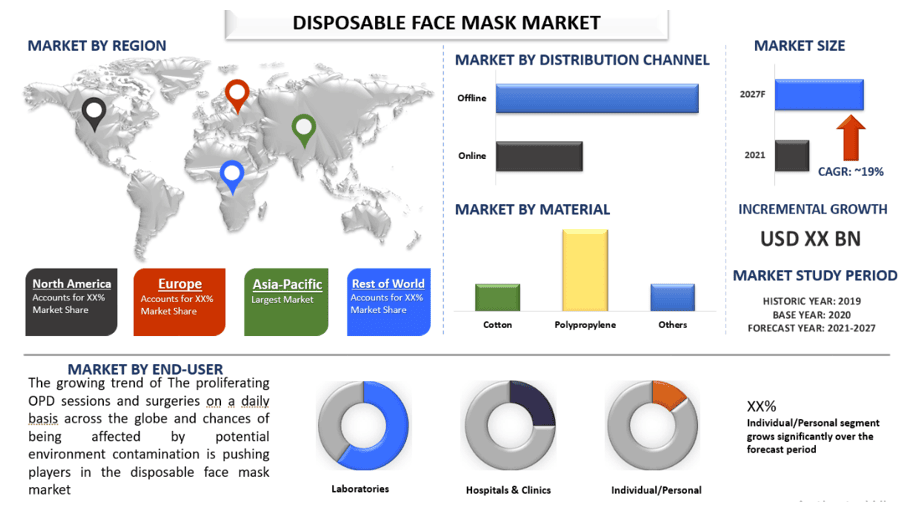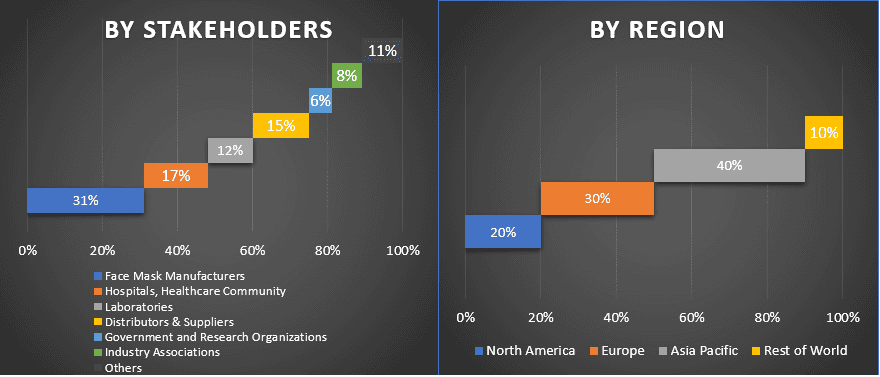- Accueil
- À propos de nous
- Industrie
- Services
- Lecture
- Contactez-nous
Marché des masques faciaux jetables : Analyse actuelle et prévisions (2021-2027)
Accent sur le type (masque chirurgical, masque anti-poussière et masque respiratoire) ; Canal de distribution (en ligne et hors ligne) ; Matériau (coton, polypropylène et autres) ; Utilisateur final (laboratoires, hôpitaux et cliniques, individuel/personnel, mines et fabrication, et industriel) ; Région/Pays

Le marché des masques faciaux jetables devrait croître à un TCAC d'environ 19 % au cours de la période de prévision (2021-2027). L'incidence élevée des infections aéroportées et la pollution croissante, la demande croissante de masques faciaux dans le secteur des soins de santé et l'adoption de masques faciaux par le public sont tous des facteurs moteurs sur le marché des masques faciaux jetables.
En 2020, l'Organisation mondiale de la santé (OMS) a estimé que 89 millions de masques médicaux sont nécessaires chaque mois pour lutter contre la COVID-19, ainsi que 76 millions de gants d'examen et 1,6 million de lunettes médicales, dans le monde entier. L'OMS estime également que l'industrie doit augmenter sa production de 40 % et exhorte les gouvernements à agir rapidement pour accroître l'offre. Cela devrait à son tour alimenter le marché des masques faciaux jetables.
Maladies aéroportées, affection de santé mondiale la plus courante, (%)

Parmi les principaux acteurs opérant sur le marché figurent 3M, Alpha Pro Tech, Ltd., Cambridge Mask Co, Cardinal Health, Inc., Honeywell International Inc., Kimberly-Clark Corporation, Moldex-Metric Inc., Prestige Ameritech, Shanghai Dasheng Health Products Manufacture Co., Ltd, The Gerson Company. Plusieurs fusions et acquisitions ainsi que des partenariats ont été entrepris par ces acteurs pour renforcer leur présence dans différentes régions.
Aperçus présentés dans le rapport
« Parmi les types, le segment des masques chirurgicaux a dominé le marché en 2020 »
Selon le type, le marché est segmenté en masques chirurgicaux, masques antipoussière et masques respiratoires. Le segment des masques chirurgicaux a détenu la part prépondérante du marché et a représenté la part importante des revenus en raison de sa demande généralisée du secteur de la santé et de sa disponibilité facile dans les hôpitaux et autres pharmacies, points de vente au détail et plateformes de distribution en ligne. De plus, ils sont moins chers que les autres types de masques.
« Parmi les canaux de distribution, le segment hors ligne a dominé le marché en 2020. »
Selon le canal de distribution, le marché des masques faciaux jetables est segmenté en ligne et hors ligne. Le segment hors ligne a dominé le marché et a représenté la part prépondérante des revenus. Les canaux de distribution hors ligne devraient jouer un rôle important dans la croissance du marché en raison de leur commodité et de leur popularité auprès des consommateurs.
« Parmi les matériaux, le polypropylène détient une part de marché importante en 2020. »
Selon le matériau, le marché est segmenté en coton, polypropylène et autres. Le segment du polypropylène a dominé la part de marché des masques faciaux. Le polypropylène non tissé (NWPP) est le matériau le plus couramment utilisé dans les masques de qualité médicale et il est utilisé à la fois dans les masques N95 et les masques chirurgicaux. Le polypropylène non tissé (NWPP) est considéré comme un bon choix pour les masques en tissu car il est léger, réutilisable, respirant, résistant à l'eau et contribue à la filtration.
« Parmi les utilisateurs finaux, les hôpitaux et les cliniques devraient connaître un TCAC important au cours de la période de prévision. »
Parmi les utilisateurs finaux, le marché des masques faciaux jetables est segmenté en laboratoires, hôpitaux et cliniques, particuliers/personnels, mines et fabrication et industrie. Les hôpitaux et les cliniques ont détenu une part importante du marché des masques faciaux jetables en 2020. En raison de la pandémie de COVID-19, la demande de masques faciaux jetables a augmenté, car ils étaient principalement consommés dans le secteur des soins de santé et par les particuliers.
« L'Asie-Pacifique représente l'un des marchés les plus importants. »
Pour une meilleure compréhension de l'adoption des masques faciaux jetables sur le marché, le marché est analysé pour les pays tels que l'Amérique du Nord (États-Unis, Canada, reste de l'Amérique du Nord), l'Europe (Allemagne, Royaume-Uni, France, Italie, Espagne, reste de l'Europe), l'Asie-Pacifique (Chine, Japon, Inde, Australie, reste de l'Asie-Pacifique) et le reste du monde. L'Asie-Pacifique a dominé le marché en 2020. La population importante contribue à la grande proportion de la région Asie-Pacifique. La Chine a été fortement touchée par la COVID-19, Wuhan en étant l'épicentre. Par conséquent, on s'attend à ce qu'il y ait une demande accrue de produits sur le marché local en raison des mandats gouvernementaux. De plus, la forte population du pays, associée à la fabrication de masse à faible coût, favorisera le taux d'adoption. Une sensibilisation accrue aux avantages des masques pour conjurer le coronavirus stimulera l'expansion de l'industrie locale.
Raisons d'acheter ce rapport :
- L'étude comprend une analyse de la taille et des prévisions du marché validée par des experts clés authentifiés de l'industrie
- Le rapport présente un aperçu rapide de la performance globale de l'industrie en un coup d'œil
- Le rapport couvre une analyse approfondie des principaux pairs de l'industrie en mettant l'accent sur les principales données financières de l'entreprise, le portefeuille de produits, les stratégies d'expansion et les développements récents
- Examen détaillé des moteurs, des contraintes, des tendances clés et des opportunités qui prévalent dans l'industrie
- L'étude couvre de manière exhaustive le marché à travers différents segments
- Analyse approfondie au niveau régional et national de l'industrie
Options de personnalisation :
Le marché des masques faciaux jetables peut être personnalisé davantage selon les besoins ou tout autre segment de marché. En outre, UMI comprend que vous pouvez avoir vos propres besoins commerciaux, alors n'hésitez pas à communiquer avec nous pour obtenir un rapport qui répond parfaitement à vos besoins.
Table des matières
L'analyse du marché historique, l'estimation du marché actuel et la prévision de l'avenir du marché des masques faciaux jetables ont été les trois principales étapes entreprises pour créer et analyser l'adoption du masque facial jetable dans diverses régions du monde. Une recherche secondaire exhaustive a été menée pour collecter les chiffres historiques du marché et estimer la taille actuelle du marché. Deuxièmement, pour valider ces informations, de nombreux résultats et hypothèses ont été pris en considération. De plus, des entretiens primaires exhaustifs ont été menés avec des experts de l'industrie à travers la chaîne de valeur de l'industrie. Après l'hypothèse et la validation des chiffres du marché grâce à des entretiens primaires, nous avons utilisé une approche descendante/ascendante pour prévoir la taille complète du marché. Par la suite, des méthodes de ventilation du marché et de triangulation des données ont été adoptées pour estimer et analyser la taille du marché des segments et sous-segments auxquels l'industrie appartient. Une méthodologie détaillée est expliquée ci-dessous.
Analyse de la taille du marché historique
Étape 1 : Étude approfondie des sources secondaires :
Une étude secondaire détaillée a été menée pour obtenir la taille du marché historique des masques faciaux jetables à partir de sources internes à l'entreprise, telles que le rapport annuel et les états financiers, les présentations aux investisseurs, les communiqués de presse, etc., et de sources externes, notamment les journaux, les actualités et les articles, les publications gouvernementales, les publications des concurrents, les rapports sectoriels, les bases de données de tiers et autres publications crédibles.
Étape 2 : Segmentation du marché :
Après avoir obtenu la taille du marché historique des masques faciaux jetables, nous avons mené une analyse secondaire détaillée pour recueillir des informations sur le marché historique et les partager pour différents segments et sous-segments pour les principales régions. Les principaux segments inclus dans le rapport sont par type, canal de distribution, matériau et utilisateur final. De plus, des analyses régionales et nationales ont été menées pour évaluer l'adoption globale du marché des masques faciaux jetables dans le contexte mondial.
Étape 3 : Analyse des facteurs :
Après avoir acquis la taille du marché historique des différents segments et sous-segments, nous avons mené une analyse des facteurs détaillée pour estimer la taille actuelle du marché. De plus, nous avons effectué une analyse des facteurs à l'aide de variables dépendantes et indépendantes telles que la pollution croissante, le risque accru de maladies aéroportées et la sensibilisation croissante à la protection de la santé et aux mesures aseptiques, etc. Les tendances historiques et leur impact d'une année sur l'autre sur la taille et la part du marché ont été analysés. Le scénario de l'offre et de la demande a également été étudié en profondeur.
Estimation et prévision de la taille actuelle du marché
Taille actuelle du marché : Sur la base des informations exploitables des 3 étapes ci-dessus, nous sommes parvenus à la taille actuelle du marché, aux principaux acteurs du marché et aux parts de marché des segments et de l'entreprise. Toutes les répartitions en pourcentage et les ventilations du marché requises ont été déterminées à l'aide de l'approche secondaire mentionnée ci-dessus et ont été vérifiées par des entretiens primaires.
Estimation et prévision : Pour l'estimation et la prévision du marché, des pondérations ont été attribuées à différents facteurs, notamment les moteurs et les tendances, les contraintes et les opportunités offertes aux parties prenantes. Après avoir analysé ces facteurs, des techniques de prévision pertinentes, c'est-à-dire une approche descendante/ascendante, ont été appliquées pour arriver à la prévision du marché jusqu'en 2027 pour différents segments et sous-segments dans les principales régions du monde. La méthodologie de recherche adoptée pour estimer la taille du marché comprend :
- La taille du marché de l'industrie, en termes de valeur (US$)
- Toutes les parts en pourcentage, les divisions et les ventilations des segments et sous-segments de marché
- Principaux acteurs du marché des masques faciaux jetables en termes de produits et services offerts. De plus, les stratégies de croissance adoptées par ces acteurs pour concurrencer sur le marché à croissance rapide.
Validation de la taille et de la part du marché
Recherche primaire : Des entretiens approfondis ont été menés avec les principaux leaders d'opinion (KOL), y compris les cadres de haut niveau (CXO/VP, chef des ventes, chef du marketing, chef des opérations et chef régional, chef de pays, etc.) dans les principaux pays. Les résultats de la recherche primaire ont ensuite été résumés et une analyse statistique a été effectuée pour prouver l'hypothèse énoncée. Les contributions de la recherche primaire ont été consolidées avec les résultats secondaires, transformant ainsi l'information en informations exploitables.
Répartition des participants primaires dans différentes régions

Ingénierie du marché
La technique de triangulation des données a été utilisée pour compléter l'estimation globale du marché et pour arriver à des chiffres statistiques précis de chaque segment et sous-segment du marché des masques faciaux jetables. Les données ont été divisées en plusieurs segments et sous-segments après avoir étudié divers paramètres et tendances dans les domaines du type, du canal de distribution, du matériau et des utilisateurs finaux pour le principal pays/région du monde.
L'objectif principal de l'étude de marché sur les masques faciaux jetables
Les tendances actuelles et futures du marché des masques faciaux jetables ont été mises en évidence dans l'étude. Les investisseurs peuvent obtenir des informations stratégiques pour fonder leur discrétion en matière d'investissements à partir de l'analyse qualitative et quantitative effectuée dans l'étude. Les tendances actuelles et futures du marché détermineraient l'attractivité globale du marché au niveau régional et national, offrant une plate-forme permettant au participant industriel d'exploiter le marché inexploité pour bénéficier d'un avantage de premier arrivé. Les autres objectifs quantitatifs des études comprennent :
- Analyser la taille actuelle et prévue du marché des masques faciaux jetables en termes de valeur (US$). Analyser également la taille actuelle et prévue du marché des différents segments et sous-segments
- Les segments de l'étude comprennent le type, le canal de distribution, le matériau et les utilisateurs finaux
- Analyser la taille actuelle et prévue du marché des masques faciaux jetables pour les principales régions et pays
- Les principales régions étudiées dans le rapport comprennent l'Amérique du Nord (États-Unis, Canada, reste de l'Amérique du Nord), l'Europe (Allemagne, Royaume-Uni, France, Italie, Espagne, reste de l'Europe), l'Asie-Pacifique (Chine, Japon, Inde, Australie, reste de l'Asie-Pacifique) et le reste du monde
- Profils d'entreprise des acteurs du marché des masques faciaux jetables et des stratégies de croissance adoptées par eux pour se maintenir sur le marché à croissance rapide
- Analyse approfondie au niveau régional et national de l'industrie
Connexes Rapports
Les clients qui ont acheté cet article ont également acheté










